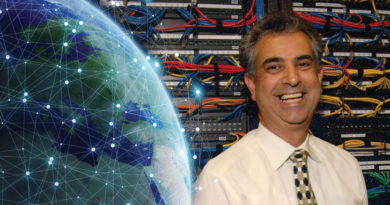Broadband Branches Out
By Dr. Rouzbeh Yassini, Ph.D.
Extending far beyond its original capabilities, broadband is showering the world with gifts that will last a lifetime. And beyond.
The gift that is broadband just keeps on giving. Nearly 20 years after publication of the original DOCSIS® specification, broadband is demonstrating an astonishing capacity for transforming the way people (and increasingly their machines) communicate, learn, conduct commerce and advance the human condition. The seeds planted in the 1990s by pioneering inventors and entrepreneurs have grown to produce a towering tree whose branches extend across our civilization, touching vital areas including transportation, energy, safety and more.
Supplying the life source for this ecosystem is an incredible flow of economic vitality. For the cable industry in particular, broadband has delivered enormous impact, supplanting the legacy video category as the industry’s economic backbone. A 2015 Deutsche Bank analysis concludes broadband will produce an $8 billion gross profit advantage over video this year ($25 billion to $17 billion) for the largest U.S. cable companies. By 2020, broadband’s profit contribution will climb to $35 billion while video profit shrinks to $12 billion.
This economic transformation reflects two powerful forces. The first is that broadband subscribers and revenue continue to rise, while the video category enters a period of stasis, if not outright decline. Through the first six months of this year the U.S. cable industry added 1.6 million broadband subscriptions, while video units fell by close to 175,000, according to Leichtman Research Group Inc. The second big force is the superior profit margin delivered by broadband, where the absence of underlying programming/content costs produces tremendous advantage.
As a result, broadband, not video, has emerged as the main contributor to the multi-trillion dollar value of the largest U.S. and global “cable” companies today. The rising role of broadband both within the cable industry ecosystem and beyond reflects a transformation that has important implications for almost every aspect of life — a point recognized earlier this year by the Obama administration in announcing its ConnectALL broadband initiative. The White House pointed out that “in today’s world, broadband and fluency with technology fuel economic growth, provide access to the world’s knowledge, promote skill development, and build stronger and more connected communities.”
![]()
Broadband’s gifts don’t stop there, of course. The establishment of broadband services and applications has given rise to enormous creativity and disruption, yielding better ways of doing things across the world for billions of individuals. Here are selected branches of the broadband tree that continue to produce enormous societal value:
Energy
We are on the cusp of a seismic change in the way the world consumes energy, with implications for efficiency improvements, cost savings and, quite possibly, a way to save Mother Earth from irreversible environmental trauma. One example among many comes from companies like Intellihot of Illinois and Virginia-based Aquanta, which have developed sensor-powered water heating systems that supply hot water only when it’s needed, rather than depending on a constant, always-on heat supply. When you contemplate the application of this type of as-needed energy distribution approach across thousands of device categories and across billions of users, you can imagine how vast the implications run. What makes these utilization improvements possible is the pairing of intelligent sensors with reliable, secure broadband networks that provide the nerve centers for a new energy economy. Broadband has provided an enormous gift to the world in the form of a newfound ability to control, moderate and reduce energy requirements, with far-reaching implications for sustainability and environmental stewardship.
Automotive
Yes, self-driving cars are coming, and fast. But even before they achieve scale on the world’s roads, an equally important revolution is happening. It’s the arrival of the intelligent car — a vehicle whose standard equipment includes a built-in gateway, switching capability and multiple sensors. With this configuration, the intelligent car can diagnose its own ailments, communicate with maintenance technicians by itself and convey operational and control information to drivers (goodbye, paper manuals). Even more important, its combination of environmental sensors and zero-latency communications capability (a requisite for self-driving cars) effectively creates a powerful new medium for conveying information not just about the car’s performance, but the environment in which it’s operating. From early warnings of imminent flood conditions to on-the-spot reporting about roadside hazards, the intelligent car collects and provides essential data at a scale we’ve never seen. This capability is an integral part of emerging “smart cities” where pedestrian and motorist safety is improved and where early warning systems for disaster recovery are greatly enhanced. Additionally, intelligent cars promise to emerge as vessels for personalized communications and data services: Remove the portable storage drive from the glove compartment and in effect, the car becomes a go-to source for data and services you can access at home, from an airplane or just about anywhere.
Health Care
The combination of broadband connectivity, personalized devices and inventive monitoring and signaling applications is producing a transformation in health care right before our eyes. The earliest of these tools came from innovators like fitness tracker Fitbit, which makes it possible not just to accurately record personalized health indicators but to catalogue and store them in the broadband-connected cloud, where they form a personalized health-data analysis repository that produces insights and invites behavioral changes. Now, take that formula and extend it across the entire personalized health domain: From critical heart-function monitoring to blood pressure evaluation to “smart” hearing aids, broadband is making possible improvements in the ability of individuals to understand and monitor their own health in ways that were never before possible. What’s more, broadband has created a new information interchange between patients and providers that allows for remote diagnosis, health counseling and provider care without the need for a time-consuming (and in many cases, expensive) visit to a physical location. The market here is growing fast: Zion Research expects the home-health monitoring category to be worth $391 billion by 2020, reflecting a 9 percent compounded annual growth rate from this year’s revenue of $228 billion.
Safety
The next big revolution in the connected society may revolve around an ages-old concern: security. Already, broadband has disrupted the old-school approach for home security. You can see the evidence as you wander through neighborhoods where houses are outfitted with 24/7 webcams and multiple internal sensors, and decorated with signs advertising providers that didn’t exist even five years ago. But the bigger revolution in safety and security goes beyond $50 per month home security systems and reaches into a much more personalized realm. The combination of broadband connectivity, smartphones, the Global Positioning System, the Internet of Things (IoT) in the house, detection applications and always-available cameras creates entirely new possibilities for conveying where we are, what we’re doing and who gets to know about it. On a broader scale, the same confluence of technologies allows us to be much more efficient in crowd-sourcing warning signs such imminent earthquakes or other looming safety compromises before they strike, making our world that much safer.
Virtualization
First, there was broadband. Providers integrated this bold new capability into the broader technology infrastructure they already possessed, layering on routers, cable modem termination systems and cable modems. Each component fit neatly into an existing delivery system. And it worked beautifully. But now we’ve reached a point where the hardware that makes broadband work is largely generic and based on open-source software, rather than dependent on proprietary boxes and protected code. This democratization of technology allows us, and in fact demands, that we elevate distribution intelligence to the cloud, where smart machines can command precisely how the network is to serve their needs, rather than the other way around. The movement toward network virtualization empowers service providers who are launching new web-based services to do so quickly, and in many cases without the need for underlying code or authoring skills. Thus, it’s easier than ever for individuals and organizations to produce, distribute and monetize original content and services. In effect, broadband enables consumers to become producers. The combination of network virtualization and cloud empowerment portends dramatic improvements in simplicity of operations, capacity, speed and performance that will usher forth even more provocative applications and possibilities while allowing next-generation service providers to flourish without the need to own and operate their own physical delivery networks.
The Cloud
Service providers of all sorts have transformed their offerings by removing them from localized physical facilities and delivering them instead from a centralized infrastructure that relies on broadband connectivity to reach end-users. The cloud revolution is transforming a myriad of industries, including software, retailing, manufacturing and more, by creating enormous efficiencies and easing capital investment demands. Nowhere is the cloud migration more palpable than in a fast-changing video category, where innovators like Amazon and Netflix have leapfrogged legacy models that depend on expensive infrastructures — headends, equipment racks, and precision-cooled environments — which must be duplicated market after market. Now, television networks like HBO, CBS and others are following in their footsteps by delivering direct-to-consumer video services that obviate intermediary distributors. This change in fundamental business model, coupled with a shifting of infrastructure to the cloud, has made it plain that cable’s current video delivery model cannot be sustained.
Family Life
Before broadband, the modern family hearth was the living room television set and the set-top box that powered it. This fixed-location device dictated the relationship with the world’s most powerful medium: If you wanted to use it, you came to it. Now, the combination of portable screens with broadband connections has turned this relationship upside down. Any display device has full rights to be whatever it wants to be: a television screen, a stereo system, a personal computer. Equally important, it can perform these functions almost anywhere a user desires, in the home or outside it. Thus, the field of play is now virtually unlimited. When “cable” companies look in the mirror today, the reflection they should see, or aspire to, is that of a do-it-all service provider, not the operator of a network with compartmentalized infrastructure for delivering video, voice and data. Those concepts are gone, replaced by the more malleable and permissive service orientation enabled by broadband and the devices that feed from it.
The Future
The angel atop our broadband tree is a better future for humanity, powered by capabilities and applications we are only beginning to realize, coupled with a determined effort to bring broadband to the billions of individuals across the world who still lack access. In education, in sensor-powered data insights, in global commerce, in collaboration and beyond, smart cities empowered by broadband will create order-of-magnitude improvements in the way we work, live, play and organize our communities. A central ingredient here is the move toward multi-gigabit symmetrical networks that liberate producers and consumers alike, and in many cases enable one to become the other.
Like a child anticipating a treasured toy, we can’t wait to see what happens next as broadband continues an exponential progression whose ultimate utility is to empower the betterment of humankind and the planet that sustains us. Because that’s a gift whose value truly is inestimable.
Dr. Rouzbeh Yassini, Ph.D.
Founder and CEO of YAS Capital Partners
Executive Director University Of New Hampshire Broadband Center Of Excellence
Dr. Rouzbeh Yassini, Ph.D. is Founder and CEO of YAS Capital Partners and is Executive Director of the University Of New Hampshire Broadband Center Of Excellence, an interdisciplinary initiative devoted to the advancement of broadband Internet technology and services. Dr. Yassini is widely known as the “father of the cable modem,” reflecting his pioneering work in cable broadband technology as the founder and CEO of LANcity and as prominent contributor to the CableLabs Data over Cable Services Interface Specification (DOCSIS®), a pillar of today’s worldwide, multi-billion dollar broadband industry.




